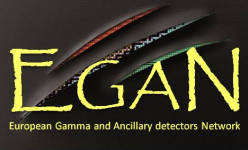Speaker
Farnaz Ghazi Moradi
(The Royal Institute of Technology-KTH)
Description
In nuclei with equal neutron and proton numbers (N=Z), the unique nature of the atomic nucleus as
an object composed of two distinct types of fermions can be expressed as enhanced correlations
arising between neutrons and protons occupying orbitals with the same quantum numbers. Such
correlations have since several decades been predicted to favour a new type of nuclear superfluidity;
isoscalar neutron-proton pairing, in addition to normal isovector pairing which dominates the
structure of most known nuclei. Despite many experimental efforts these predictions have not been
confirmed. N=Z nuclei with mass number > 90 can only be produced in the laboratory with very
low cross sections. The related problems of identifying and distinguishing such reaction products
and their associated gamma rays from the vast array of N>Z nuclei that are present in much greater
numbers from the reactions used have prevented observation of their low-lying excited states until
recently.
In the present work the experimental difficulties have been overcome through the use of a highly
efficient, state-of-the-art detector system and a prolonged experimental running period.
Gamma-ray transitions from excited states in 92Pd were identified at the Grand Accelerateur
National d'Ions Lourds (GANIL), France, using a combination of state-of-the-art high-resolution
gamma-ray, charged particle, and neutron detector systems: The EXOGAM HPGe detector array
coupled to the Neutron Wall liquid scintillator detector array and the DIAMANT CsI(Tl) charged
particle detector system. The results have revealed evidence for a transition from normal
superfluidity and seniority coupling, to an isoscalar spin-aligned coupling scheme in the ground
states and low-lying excited states of the heaviest N=Z nuclei [1]. This new neutron-proton “paired
phase” is different from the earlier predictions of a neutron-proton BCS type of pairing condensate
and is predicted to have a considerable impact on the level structures and ground state properties of
the heaviest N~Z nuclei. The talk will mainly focus on data analysis aspects and the experimental
results.
1. B. Cederwall et al., Nature 469, 68 (2011)
Primary author
Bo Cederwall
(The Royal Institute of Technology-KTH)
Co-author
Farnaz Ghazi Moradi
(The Royal Institute of Technology-KTH)

